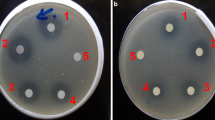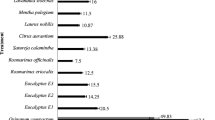Abstract
A phytotoxic fraction of high molecular weight was isolated from the culture filtrate ofClavibacter michiganensis subsp.michiganensis, the causal agent of bacterial canker of tomato, and partly purified. This high molecular weight fraction consists of sugars and a minor protein moiety and is therefore probably of similar nature to that of the toxin fromC. michiganensis subsp.michiganensis reported earlier in literature.
The high molecular weight fraction was albe to induce wilting, the predominant symptom of the disease, as shown in a bioassay with tomato cuttings. However, this wilting reaction turned out to be non-specific in the bioassay, since (partially) resistant and susceptible genotypes responded similarly. No correlation could be found between the degree of virulence of fiveC. michiganensis subsp.michiganensis strains and the amount of the phytotoxic high molecular weight fraction produced in vitro.
As the isolated high molecular weight fraction showed a phytotoxic effect on tomato plants it is worthwhile to test its potential for use as a selective agent in in vitro selection.
Samenvatting
Een fytotoxische fractie werd geïsoleerd uit cultuurfiltraat vanClavibacter michiganensis subsp.michiganensis, de veroorzaker van de bacterieverwelkingsziekte bij tomaat. Een eerste karakterisering toonde aan dat deze toxische fractie hoog-moleculaire component(en) bevat, bestaande uit polysacchariden en een gering percentage eiwit. Dit is in overeenstemming met toxines vanC. michiganensis subsp.michiganensis die al eerder beschreven zijn.
Deze hoogmoleculaire toxische fractie was in staat verwelking te induceren van stengeltoppen van verschillendeLycopersicon esculentum enL. peruvianum genotypen in een bioassay. Gewichtsverandering van de stengeltoppen, uitgedrukt als percentage ten opzichte van het begingewicht, werd gebruikt als parameter voor verwelking. De toxische fractie reageerde niet-specifiek in de bioassay, want er werd geen verschil gevonden in respons van (partieel) resistente en gevoelige genotypen. Er bleek geen correlatie te zijn tussen de mate van virulentie van verschillende isolaten vanC. michiganensis subsp.michiganensis en de hoeveelheid van de toxische fractie geproduceerd in vitro.
Het mogelijke gebruik van deze hoogmoleculaire toxische fractie als selectief agens bij in vitro selectie zal nader onderzocht worden.
Similar content being viewed by others
References
Bradshaw-Rouse, J.J., Whatley, M.H., Coplin, D.L., Woods, A., Sequeira, L. & Kelman, A., 1981. Agglutination ofErwinia stewartii strains with a corn agglutinin: correlation with extracellular polysaccharide production and pathogenicity. Applied and Environmental Microbiology 42: 344–350.
Dische, Z., 1962. General color reactions. Methods in Carbohydrate Chemistry 1: 478–512.
Husain, A. & Kelman, A., 1958. Relation of slime production to mechanism of wilting and pathogenicity ofPseudomonas solanacearum. Phytopathology 48: 155–165.
Ingram, D.S. & McDonald, M.V., 1986. In vitro selection of mutants. Proceedings IAEA/FAO symposium ‘Nuclear techniques and in vitro culture for plant improvement’, Vienna, August 1985: 241–257.
Krämer, R., 1986. Darstellung und Teilcharakterisierung des Toxins vonCorynebacterium michiganense pv.michiganense (Smith) Jensen. Zentralblatt für Mikrobiologie 141: 327–335.
Krämer, R. & Leistner, H.-U., 1986. Physiologische und cytologische Aspekte der Wirkung des Toxins vonCorynebacterium michiganense pv.michiganense (Smith) Jensen auf die Wirtspflanze. Zentralblatt für Mikrobiologie 141: 437–451.
Laterrot, H., Brand, R. & Daunay, M.C., 1978. La résistance àCorynebacterium michiganense chez la tomate. Annales de l'Amélioration des plantes 28: 579–591.
Leyns, F. & Cleene, M. de, 1983. Histopathology of the bacteriosis caused by inoculation ofCorynebacterium michiganense andXanthomonas campestris pv.vesicatoria. Mededelingen Faculteit Landbouwwetenschappen Rijksuniversiteit Gent 48: 663–670.
Lindhout, P. & Purimahua, C., 1987. Resistance againstCorynebacterium michiganense found inLycopersicon peruvianum. Synopses 10th Meeting Eucarpia Tomato Working Group. September 1987: 162–165.
Lowry, O.H., Rosebrough, N.J., Farr, A.L. & Randall, R.J., 1951. Protein measurement with the folin phenol reagent. Journal of Biological Chemistry 193: 265–275.
Patiño-Méndez, G., 1964. Studies on the pathogenicity ofCorynebacterium michiganense (E.F. Sm.) Jensen and its transmission in tomato seed. PhD Thesis, University of California, Davis. 53 pp.
Rai, P.V. & Strobel, G.A., 1969a. Phytotoxic glycopeptides produced byCorynebacterium michiganense. I. Methods of preparation, physical and chemical characterization. Phytopathology 59: 47–52.
Rai, P.V. & Strobel, G.A., 1969b. Phytotoxic glycopeptides produced byCorynebacterium michiganense. II. Biological properties. Phytopathology 59: 53–57.
Scheffer, R.P., 1976. Host-specific toxins in relation to pathogenesis and disease resistance. In: Heitefuss, R. & Williams, P.H. (Eds), Physiological plant pathology. Springer-Verlag, Berlin, p. 247–269.
Scheffer, R.P., 1983. Toxins as chemical determinants of plant disease. In: Daly, J.M. & Deverall, B.J. (Eds), Toxins and plant pathogenesis. Academic Press, New York, p. 1–40.
Steekelenburg, N.A.M. van, 1985. Resistance totCorynebacterium michiganense in tomato genotypes. Euphytica 34: 245–250.
Van Alfen, N.K. & Allard-Turner, V., 1979. Susceptibility of plants to vascular disruption by macromolecules. Plant Physiology 63: 1072–1075.
Van Alfen, N.K. & McMillan, B.D., 1982. Macromolecular plant-wilting toxins: artifacts of the bioassay method? Phytopathology 72: 132–135.
Wallis, F.M., 1977. Ultrastructural histopathology of tomato plants infected withCorynebacterium michiganense. Physiological Plant Pathology 11: 333–342.
Watterson, J.C., 1986. Diseases caused by bacteria. In: Atherton, J.G. & Rudich, J. (Eds), The tomato crop. Chapman and Hall, London, New York, p. 443–484.
Wenzel, G., 1985. Strategies in unconventional breeding for disease resistance. Annual Review of Phytopathology 23: 149–172.
Yoder, O.C., 1983. Use of pathogen-produced toxins in genetic engineering of plants and pathogens. In: Kosuge, T., Meredith, C.P. & Hollander, A. (Eds), Genetic engineering of plants. Plenum Press, New York, p. 335–353.
Author information
Authors and Affiliations
Rights and permissions
About this article
Cite this article
Van Den Bulk, R.W., Löffler, H.J.M. & Dons, J.J.M. Effect of phytotoxic compounds produced by Clavibacter michiganensis subsp. michiganensis on resistant and susceptible tomato plants. Netherlands Journal of Plant Pathology 95, 107–117 (1989). https://doi.org/10.1007/BF01997478
Accepted:
Issue Date:
DOI: https://doi.org/10.1007/BF01997478




